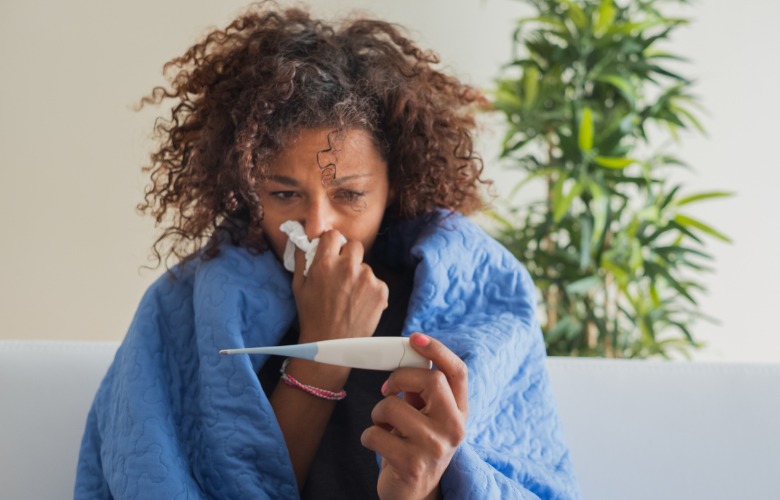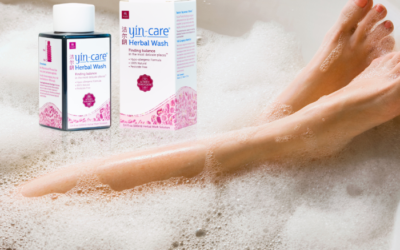Top 5 Chinese Formulas for Cold and Flu
Traditional Chinese Medicine (TCM) uses the terms Wind-Heat and Wind-Cold to describe colds and the flu. Wind is how the Heat or Cold, enter the body. The upper back and neck are particularly vulnerable to wind invasions. Wearing a scarf helps protect this area. Wind also refers to the way the illness moves around the body. If the illness is not resolved in the early stages the symptoms will move deeper and change location. Who hasn’t had a cold that started with a sore throat, progressed into a study runny nose, then became a cough? That’s wind in the body. Heat and Cold refer to the type of symptoms. I’ll go over those in more detail with each of the formulas. As you read the description of each pattern bear in mind all the symptoms do NOT need to be present for a good match. Just most of them.
1. Yin Qiao
First on our list is Yin Qiao or sometimes spelled Yin Chiao. First recorded in 1798 C.E., Yin Qi-ao was developed to combat diseases introduced via the Silk Road. Doctors found that these diseases tended to present with heat symptoms. This was contrary to the then-current thinking. The accepted school of thought was that all disease was the result of cold damage and showed up as Wind-Cold. The Silk Road diseases were different and they moved through the population faster. In the early days of its use, Yin Qiao was most often used to treat childhood chickenpox and measles. In these illnesses, we can see the heat the form of fever and red rashes. It makes sense that these symptoms would be associated with Heat. Common cold with Heat doesn’t present with a rash, but there are other Heat signs. A Wind-Heat illness typically starts with a sore throat and fever or fever and slight chills. Later the patient develops other symptoms: headache, aversion to heat, cough, upper backache, sore throat, a dry feeling around mouth and nose. Phlegm will be yellow, and the patient is often thirsty.(1)
Yin Qiao works best in the early stages because most of the herbs work to release heat from the surface of the body. The key symptom is a sore throat. For a full appreciation of this ancient formula let’s take a quick tour through its ingredients.
The two main herbs are reflected in the name. Yin for Jin Yin Hua ( Flos Lonicerae ) and Qiao for Lian Qiao ( Fructus Forsythiae ). Both are cooling herbs and we want to cool the heat! They also release the exterior. That means they clear the heat from the Wei or surface layer of the body, this includes the lungs, nose and by association the throat. In biomedical terms, they are antiviral antibiotic, anti-inflammatory, and antipyretic.(2)(3)
2. Jie Geng
The next important herb is Jie Geng ( Radix Platycodi Grandiflora ). This handy root can be used for any cough and phlegm. It brings herbs to the upper body and so is helpful for sore throat.(2) Biomedically it is an expectorant, anti-tussive, analgesic, and anti-inflammatory.
Also used for coughing and sore throat are Nui Bang Zi ( Fructus Arctic Lappae ), Bo He ( Herba Menthe Haplocalycis). Both are antipyretic and anti-inflammatory.(2)(3) The next two herbs gently support the heat-clearing herbs by boosting the releasing actions of the formula. The heat must be removed from the body. Dan Dou Chi, ( Semen Sojae Preparatum ) and Jing Jie ( Herba Schizonepetae ) can be used for either Wind-Heat or Wind-Cold. Dan Zhu Ye ( Herba Lophatheri Gracilis) and Lu Gen ( Rhizome Phragamitis Communis ) clear heat and help soothe irritability and dryness. Gan Cao, ( Radix Glycyrrhizae ) harmonizes all the herbs in the formula and stops cough, clears heat, disperses wind-heat, resolves toxicity.(2) Biomedically it is anti-inflammatory, increases phagocytosis, anti-tussive, expectorant, and antibiotic. (3)
Usage: Take for 24 hours starting at the first signs of sore throat. Reduce serving size if diarrhea or digestive upset occurs. Yin Qiao should be used only for Wind-Heat. It can be used preventatively at a lesser dose or once a day. Because the formula addresses rashes it is useful in treating Poison Oak and Poison Ivy. Yin Qiao is contraindicated for Wind-Cold. The symptoms for Wind-Cold would be, obviously, colder. The chills would be stronger, a feeling of cold or stiffness in the upper back or neck, headache, and nasal congestion, and clear phlegm.
3. Gan Mao Ling
If you’ve taken Yin Qiao and it’s been a couple of days and you are not better, the illness has penetrated more deeply. At this point, another formula should be used or added. Gan Mao Ling is a good choice. Gan Mao Ling is a relatively new formula, just three decades or so old. It is very popular in China as a remedy for the common cold and flu. Indeed Gan Mao Ling translates as to “Common Cold Effective Remedy” and sometimes “Miraculous Cold Pills”. Gan Mao Ling is a go-to for the Wind-Heat and Wind-Cold patterns. This latter has sparked controversy amongst some herbalists. All the herbs listed are cold or cooling, so how is it they are treating a Wind-Cold condition? Clinical experience does support the Wind-Cold or Wind-Heat claim. Overall Gan Mao Ling is rife with antivirals to wit Gang Mei Gen ( Radix Ilex Asprella ), San Cha Ku ( Radix Evodia Lepta ), Ban Lan Gen ( Radix Isatis ), and Jin Yin Hua ( Flos Lonicera ). Gang Mei Gan and San Cha Ku make up more than 50% of the formula and they are not your every-day cold herbs. This may explain why clinically this formula also works for Wind-Cold. Gang Mei Gen is effective against the flu virus. (6) It clears toxins and regulates and tonifies Lung and body Qi. (3) San Cha Ku is traditionally used for intestinal complaints and strengthening the nervous system. Studies show it decreases inflammation and is a promising therapy for Alzheimer’s. (7)(8) Both these herbs support the body and the nervous system and address back-ground inflammation. In this way, Gan Mao Ling also treats the deficiency that invites Wind-Cold patterns thus making it useful for Heat and Cold Wind.
Usage: Use Gan Mao Ling after Yin Qiao or if the nose is first to complain. Gan Mao Ling is most effective when started in the early stages of invasion. Taken throughout the illness it will soften symptoms and speed recovery. The formula may be used for a few days to a few weeks. Gan Mao Ling can be used as a preventative. If you feel you have been exposed to a cold or flu or you are going to be around a crowd of people; serve it up. Use with caution in deficient or cold patients. Contraindicated if strong chills are present.
4. Bi Yan Pian
If it all about the nose get some Bi Yan Pian AKA Nose inflammation pills. Bi Yan Pian is most likely based on Xanthium Powder from “Formulas to Aid the Living” (1253 CE). It is the bomb for almost anything nose related. A versatile formula treats acute and chronic sinusitis and allergies. Phlegm can be clear white or colored. It’s perfect for head colds with yellow, white or clear discharge and stuffiness. The ingredients of Bi Yan Pian can vary depending on the manufacturer. The following are the most commonly used herbs and their contributions to the working of the formula.(2)
- Cang Er Zi (Xanthium Sibiricum) This warm little herb looks like it would be right at home in the nose. Just the right size and shape. It is used in a formula for ANY sinus or nose problems with thick discharge. Also effective with the headache and neck ache which comes with the common cold.
- Xin Yi Hua (Magnolia Biondii) Another warm herb for the nose. It gets rid of blocked nasal passages. Although it is warm it can be used for ANY nose or sinus condition.
- Lian Qiao (Forsythia Suspensa) One of the stars of Yin Qiao plays a key role here by addressing the Wind-Heat symptoms and clearing toxins.
- Fang Feng (Saposhnokovia Divaricate) We’ve heard a lot about wind, finally there’s an herb whose superpower is calming the wind. The temperature of this herb is warm making sure the cold wind is shown the proverbial door.
- Zhi Mu (Anemarrhena Asphodeloides) Dual functions are the key to this herb. Clears away bothersome heat and moistens dryness by generating fluid.
- Bai Zhi (Angelica Dahurica) opens up the nasal passages so you can breathe again!
- Gan Can (Radix Glycyrrhizae) Helps with the sore throat and cough that comes with nose is-sues. It also harmonizes all the herbs in the formula. Jing Jie ( Schizonepeta tenuifolia ) treats both Wind-Heat and Wind-Cold conditions.
- Ye Ju Hua (Chrysanthemum Indicum) A flower for Wind and Heat. It helps the eyes for the excessive tearing that can come with nose inflammation.
- Jie Geng (Platycodon Grandiflorum) Guides all the herbs to the upper portion of the body and helps with phlegm and cough.
Use with caution if you are pregnant or have Yin deficiency.
5. Gui Zhi Tang
Gui Zhi Tang is a tasty formula for Wind-Cold. All the formulas so far have addressed Wind-Heat or both Wind-Heat and Wind-Cold. In colder climes, with colder constitutions or with old-er folks a Wind-Cold is more likely than a Wind-Heat. The symptoms are fever and strong chills or just chills, headache, aversion to wind, stiff neck, nasal congestion, clear phlegm, and nausea.
Gui Zhi Tang was first recorded in c.220 in the classic time Shang Han Lun AKA Discussion of Cold Damage. It is a relatively small formula, just five herbs, each playing a role in releasing the Wind-Cold and shoring up the body. Gui Zhi ( Cinnamomi Ramulus ) sets the tone by achieving both of these actions. It’s always good to have a sidekick or two. Sheng Jiang ( Zingiberis Rhizoma ) that is to say fresh ginger helps to get the cold wind out and helps with stomach upset. Da Zao ( Jujubae Fructus ) helps Gui Zhi with strengthening the body through harmonizing the blood and the ability to use nutrition. Fried licorice, Zhi Gan Cao ( Glycyrrhizae Radix Preparata ) harmonizes all the ingredients. Bai Shao ( Paeoniae Radix Alba ) like Da Zao helps with the nutritive side of things, it also puts any errant Yang Qi ( hot flashes )back in his place.(1)(2)
Now you know based on the pattern of symptoms which herb formula will work best for you if you do get sick. Don’t forget the basics. Wear a scarf, wash your hands, move away from people who are coughing. Stay well and happy!Serving size
For all formulas listed can vary depending on the form and brand. Check the label or follow the instructions of your knowledgeable health care practitioner.
Disclaimer
Use herbs wisely. If you have questions or special considerations, work with your practitioner. If symptoms worsen or you have concerns, contact a knowledgeable practitioner. These statements have not been evaluated by the Food and Drug Administration. These products are not intended to diagnose, treat, cure or prevent any disease. Please check for interactions if you are taking any medications and intend to ingest herbal products.
References
1 Bensky, Scheid, Ellis, Barolet Formulas and Strategies. Portable 2nd edition. Eastland Press Inc. 2015
2 Bensky, Gamble, Chinese Herbal Medicine Materia Medica, Revised Edition, Eastland Press, 1993
3 Chen, Chinese Medical Herbology and Pharmacology, Art of Medicine Press, 2004
4 Yang, The Divine Farmer’s Materia Medica, A Translation of the Shen Non Ben Cao Jing, Blue Poppy Press Inc, 1998
5 Jake Paul Fratkin, OMD, L.Ac. TCM ANTI-VIRAL THERAPY Using Wen Bing Theory in the Treatment of Modern Epidemics, CEU class,
6 Peng MH, Dai WP, Lui SJ, Yu SW, Wu YN, Lui R, Chen XL, Lai XP, Li X, Zhao ZX, Li G. Bioactive glycosides from the roots of Ilex asprella. Pharmaceutical Biology2016 Oct;54(10):2127-34 https://www.ncbi.nlm.nih.gov/pubmed/26957139
7 Ju Young Yoona, Hye Yoon Jeong, Shi Hyoung Kim, Han Gyung Kim, Gyeongsug Nam, Jin Pyo Kim, Deok Hyo Yoon, HyunsikHwang, Tae Woong Kim, Sungyoul Hong, Jae Youl Cho, Methanol extract of Evodia lepta displays Syk/Src-targeted anti-inflammatory activity, Journal of Ethnopharmacology, Vol. 148 Issue 3, 30 July 2013, Pages 999-1007
https://www.sciencedirect.com/science/article/pii/S0378874113003668
8 Sichaem J, Rojpitikul t, Sawasdee P, Lugannanagarm K, Santi TP, Furoquinoline Alkaloids from the Leaves of Evodia lepta as Potential Cholinesterase Inhibitors and their Molecular Docking. Natural Product Communication, 2015 Aug;10(8):1359-62.
https://www.ncbi.nlm.nih.gov/pubmed/26434116

A licensed acupuncturist since 1999, Diana lives and works in Santa Cruz, California. Her practice focuses on pain management, stress reduction, and creating health. A longtime friend of plants, she loves the herbal side of Traditional Chinese Medicine. Diana shares her herbal interests through writing and a card game she designed and illustrated: Herb Apocalypse*. Volunteer work includes The Rabbit Haven, a rabbit rescue, and Livity Rising, free community healing clinics. Author of Herb Apothecary: The Coloring Book: 54 Chinese Herbs available on Amazon.



